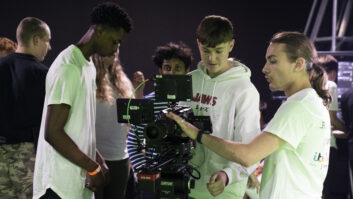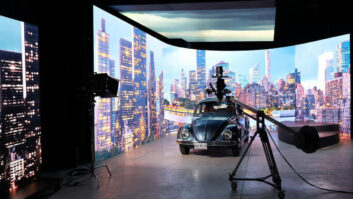
Visitors to the National Geographic Museum in Washington, D.C. are able to virtually explore Jerusalem in a new exhibition, “Tomb of Christ: The Church of the Holy Sepulchre Experience”.
Electrosonic, a specialist in using technology to create and enhance visual experiences, was selected by themed entertainment design firm Falcon’s Creative Group to help build the immersive 3D experience using a number of innovative technology solutions often found in themed attractions.
“Electrosonic brought their tremendous expertise in designing seamless AV and show control systems for the theme park and attractions industry to ‘Tomb of Christ'”, says Jason Ambler, Executive Producer/Director of Production at Falcon’s Creative Group. “Electrosonic helped to create an immersive exhibition that shatters expectations of what a museum experience should be.”
Falcon’s Creative Group had previously worked with Electrosonic on “Heroes and Legends” and the “U.S. Astronaut Hall of Fame” at the Kennedy Space Center Visitor Complex and the new “The Battle for Eire” at Busch Gardens, Williamsburg. Falcon’s Creative Group provided the overall design and project management, as well as the immersive media content for the “Tomb of Christ” exhibition.

Built in the fourth century, the Tomb of Christ, or the Holy Edicule located inside the Church of the Holy Sepulchre, recently underwent a historic restoration, a project that was featured last winter in National Geographic magazine and on the National Geographic channel. In the exhibition, visitors learn about the restoration effort and how National Geographic Explorers are using new technologies including lidar, photogrammetry, sonar, laser scanning and thermal imaging to continue to study this important site.
Visitors buy timed tickets for “Tomb of Christ” and follow a narrative pathway through several consecutive scenes. “It’s not a typical free-roaming exhibit but a uniquely phased journey through the story of the church with progressively complex show elements at each stage. Electrosonic integrated and programmed various forms of projection mapping and show action to seamlessly transition through each chapter of the experience, reaching a climax inside an immersive 3D holodeck theater,” Ambler says.
Visitors begin to orient themselves in the queue line where monitors display an introductory video on the restoration of the church. They see its location in the Old City of Jerusalem and discover how their museum visit intersects with restoration, architecture, history, technology, science and faith.
Then doors open to show a projection table and giant pull-down screen detailing the geography of the church site. The screen rises, and visitors walk through a bazaar leading to a 360º view of the church courtyard formed by two perpendicular walls of still super graphic images and two perpendicular walls of projected content. A video host explains the complex architectural history of the structure.

Next, double doors in the courtyard open leading into the church. A “holodeck” 3D experience awaits visitors as projections on the walls and floor give them an unprecedented look at the site. “It’s an extraordinary 3D active shutter experience with wrap-around renders of more than 10K resolution,” says Ambler. Falcon’s Creative Group digitally recreated the church using high-resolution scan data captured by the National Geographic team during the restoration process.
Visitors fly past mosaics and archways to the Holy Edicule under the rotunda. They rotate around the shrine then fly out and over the city to see the evolution of the church site over the centuries. Visitors return to the Holy Edicule where they view the outer and inner chambers and, in the final scene, get an aerial perspective of Easter’s Holy Fire ceremony where the flames from thousands of candles held by clergy and pilgrims encircle the sacred space.
Electrosonic provided HD displays for the exhibition’s queue line video. Pairs of Christie laser phosphor projectors were furnished for the projection table, pull-down screen, and for the courtyard’s 12-foot high perpendicular walls, which act as projection surfaces. Electrosonic upped the projector count for the 3D experience supplying seven Panasonic Active 3D HD laser projectors for the 10-foot high walls and eight Christie HD laser projectors to cover the floor. All 15 projectors are edge blended to create a single seamless and immersive vantage point for the audience. 7th Sense media servers and BrightSign media players source the content.
Electrosonic provided 5.1 surround audio for the projection table room and the courtyard, as well as 7.1 surround audio for the 3D experience, including a QSC Core 110f audio digital signal processor.
A Medialon Show Master Pro 2 show controller runs “Tomb of Christ” with two Apple iPads featuring custom, user-friendly interfaces for operators. “Electrosonic was really great about training the National Geographic staff and setting up a system that’s really streamlined for their museum operations team. That’s key to maintaining the continuity of the guest experience long after opening day,” notes Ambler.
“We’re thrilled to collaborate with Electrosonic on any project,” he adds. “Their focus on quality and their ownership of the final product aligns with our creative goals and vision which results in happy clients and great projects.”
“It was great to work with Falcon’s Creative Group, a key partner of ours on many projects,” says Fred Davidowitz, Electrosonic’s Project Manager. “The National Geographic Museum team and their Creative Director, Alan Parente, also did fine work in a challenging time frame enabling us to meet deadlines for the press tours and grand opening.”
At Electrosonic, Philip J. DiPaula, was the Account Executive for the project.







